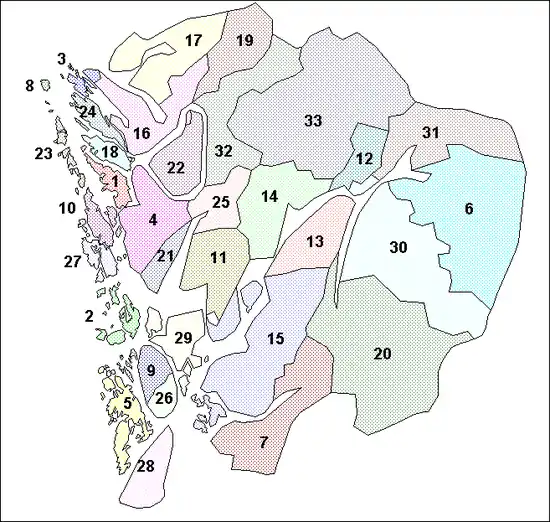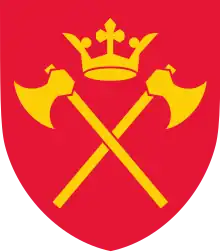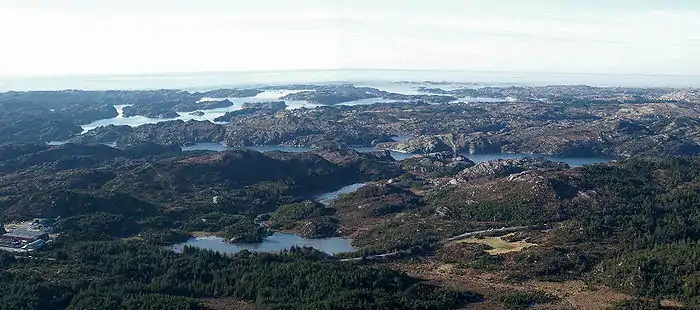Hordaland
Hordaland (Urban East Norwegian: [ˈhɔ̂rdɑlɑn] (![]() listen)) was a county in Norway, bordering Sogn og Fjordane, Buskerud, Telemark, and Rogaland counties. Hordaland was the third largest county after Akershus and Oslo by population. The county government was the Hordaland County Municipality which is located in Bergen. Before 1972, the city of Bergen was its own separate county apart from Hordaland. On 1 January 2020, the county was merged with neighbouring Sogn og Fjordane county to form the new Vestland county.
listen)) was a county in Norway, bordering Sogn og Fjordane, Buskerud, Telemark, and Rogaland counties. Hordaland was the third largest county after Akershus and Oslo by population. The county government was the Hordaland County Municipality which is located in Bergen. Before 1972, the city of Bergen was its own separate county apart from Hordaland. On 1 January 2020, the county was merged with neighbouring Sogn og Fjordane county to form the new Vestland county.
Hordaland fylke | |
|---|---|
 Hardangerfjord in July 2012 | |
 Hordaland within Norway | |
| Coordinates: 60°15′N 06°00′E | |
| Country | Norway |
| County | Hordaland |
| Region | Vestlandet |
| County ID | NO-12 |
| Administrative centre | Bergen |
| Government | |
| • Governor | Lars Sponheim Venstre (2010–2019) |
| • County mayor | Anne Gine Hestetun Arbeiderpartiet (2015–2019) |
| Area | |
| • Total | 15,460 km2 (5,970 sq mi) |
| • Land | 14,551 km2 (5,618 sq mi) |
| Area rank | #9 in Norway, 4.78% of Norway's land area |
| Population (February 7, 2021 est.)[1] | |
| • Total | 536,000 |
| • Rank | 3 (9.72% of country) |
| • Density | 35/km2 (90/sq mi) |
| • Change (10 years) | 7.9 % |
| Demonym(s) | Hordalending |
| Time zone | UTC+01 (CET) |
| • Summer (DST) | UTC+02 (CEST) |
| Official language form | Nynorsk |
| Income (per capita) | (EUR 18,500) 148,000 NOK |
| GDP (per capita) | (EUR 33,000) 263,000 NOK (2001) |
| GDP national rank | 2 (7.55% of country) |
| Website | www |
Name and symbols
Name
Hordaland (Old Norse: Hǫrðaland) is the old name of the region which was revived in 1919. The first element is the plural genitive case of hǫrðar, the name of an old Germanic tribe (see Charudes). The last element is land which means "land" or "region" in the Norwegian language.
Until 1919 the name of the county was Søndre Bergenhus amt which meant "(the) southern (part of) Bergenhus amt". (The old Bergenhus amt was created in 1662 and was divided into Northern and Southern parts in 1763.)
Flag

Hordaland's flag shows two golden axes and a crown in red. The flag is a banner of the coat of arms derived from the old seal of the guild of St. Olav from Onarheim in Tysnes municipality. This seal was used by the delegates of Sunnhordland in 1344 on the document to install king Haakon V of Norway. It was thus the oldest symbol used for the region and adapted as the arms and flag in 1961. The symbols refer to the patron saint of the guild, Saint Olav, King of Norway, whose symbol is an axe.[2]
Coat of arms
The coat-of-arms were officially granted on 1 December 1961. They were designed by Magnus Hardeland, but the general design had been originally used in the Sunnhordland region during the 14th century. In the early 20th century, leaders of the county began using the old arms as a symbol for the county once again. The arms are on a red background and consist of two golden axes that are crossed with a golden crown above them.[3]
History
| Year | Pop. | ±% |
|---|---|---|
| 1769 | 63,757 | — |
| 1900 | 205,771 | +222.7% |
| 1950 | 308,164 | +49.8% |
| 1960 | 338,265 | +9.8% |
| 1970 | 369,430 | +9.2% |
| 1980 | 388,084 | +5.0% |
| 1990 | 407,427 | +5.0% |
| 2000 | 435,219 | +6.8% |
| 2010 | 477,175 | +9.6% |
| 2014 | 508,500 | +6.6% |
| Source: Statistics Norway.[4][5] | ||
Hordaland county had been around for more than one thousand years. In the 7th century, the area was made up of many petty kingdoms under the Gulating and was known as Hordafylke from around the year 900. In the early 16th century, Norway was divided into four len. The Bergenhus len was headquartered in Bergen and encompassed much of western and northern Norway.[8]
In 1662, the lens were replaced by amts. Bergenhus amt originally consisted of the present-day areas of Hordaland, Sogn og Fjordane, and Sunnmøre and the far northern Nordlandene amt was subordinate to Bergenhus. In the 1680s, Nordlandene and Sunnmøre were split from Bergenhus. In 1763, the amt was divided into northern and southern parts: Nordre Bergenhus amt and Søndre Bergenhus amt. When the amt was split, the present day municipality of Gulen was split with the southern part ending up in Søndre Bergenhus amt. In 1773, the border was re-drawn so that all of Gulen was located in the northern part. Søndre Bergenhus amt was renamed Hordaland fylke in 1919.[8]
The city of Bergen was classified as a city-county (byamt) from 1831–1972. During that time in 1915, the municipality of Årstad was annexed into Bergen. In 1972, the neighbouring municipalities of Arna, Fana, Laksevåg and Åsane were annexed into the city of Bergen. Also at that same time, the city of Bergen lost its county status, and became a part of Hordaland county.[8]
Government
A county (fylke) is the chief local administrative area in Norway. The whole country is divided into 19 counties. A county is also an election area, with popular votes taking place every 4 years. In Hordaland, the government of the county was the Hordaland County Municipality. It included 57 members elected to form a county council (Fylkesting). Heading the Fylkesting was the county mayor (fylkesordførar). The last county mayor for the Hordaland County Municipality was Anne Gine Hestetun.
The county also had a County Governor (fylkesmann) who was the representative of the King and Government of Norway. Lars Sponheim was the last County Governor of Hordaland. The municipalities in Hordaland were divided among four district courts (tingrett): Nordhordland, Sunnhordland, Bergen, and Hardanger. Hordaland was also part of the Gulating Court of Appeal district based in Bergen.[8]
- Nordhordland District Court: Askøy, Austevoll, Austrheim, Fedje, Fjell, Fusa, Lindås, Masfjorden, Meland, Modalen, Os, Osterøy, Radøy, Samnanger, Sund, Vaksdal, Voss, Øygarden, and Gulen (Gulen was actually in neighbouring Sogn og Fjordane county)
- Sunnhordland District Court: Bømlo, Etne, Fitjar, Kvinnherad, Stord, Sveio and Tysnes
- Bergen District Court: the city of Bergen
- Hardanger District Court: Eidfjord, Granvin, Jondal, Kvam, Odda, Ullensvang and Ulvik
Most of the municipalities in Hordaland were part of the Hordaland police district. Gulen and Solund in Sogn og Fjordane county were also part of the Hordaland police district. Bømlo, Etne, Fitjar, Stord and Sveio were a part of the "Haugaland and Sunnhordland" police district, along with eight other municipalities in Rogaland county.[8]
Geography

Hordaland is semi-circular in shape. It is located on the western coast of Norway, split from southwest to northeast by the long, deep Hardangerfjorden, one of Norway's main fjords and a great tourist attraction. About half of the National park of Hardangervidda is in this county. The county also includes many well-known waterfalls, such as Vøringsfossen and Stykkjedalsfossen. It also includes the Folgefonna and Hardangerjøkulen glaciers.
More than 60% of the inhabitants live in Bergen and the surrounding area. Other urban or semi-urban centres include Leirvik, Voss and Odda.

Municipalities
Districts
Parishes
- Alversund
- Arna
- Ask
- Askøy
- Austevoll
- Austrheim
- Bekkjarvik
- Bergen
- Bergsdalen
- Birkeland
- Biskopshavn
- Bjoastrand
- Blomvåg
- Bremnes
- Bruvik
- Bømlo
- Old Bømlo
- Bønes
- Dale
- Eid
- Eidfjord
- Old Eidfjord
- Eidsvåg
- Eksingedal
- Emigrant
- Erdal
- Etne
- Evanger
- Fana
- Fedje
- Finnås
- Fitjar
- Fjelberg
- Fjell
- Fjæra
- Foldnes
- Førde
- Fridalen
- Frøyset
- Fusa
- Fyllingsdalen
- Gjerde
- Gjerstad
- Granvin
- Grindheim
- Haga
- Hamre
- Hatlestrand
- Haus
- Herdla (Herlø)
- Hjelme
- Old Hjelme
- [[Holdhus Church]|Holdhus]
- Holmedal
- Holy Cross
- Hordabø (Bøe)
- Hosanger
- Hundvin
- Hundvåkøy
- Husnes
- Hålandsdal
- Jondal
- Kausland
- Kinsarvik
- Knarvik
- Kvam
- Kvinnherad
- Laksevåg
- Landro
- Landås
- Lindås
- Loddefjord
- Lygra
- Lykling
- Manger
- Masfjorden
- Meland
- Mjelde
- Mo
- Moster
- Old Moster
- Myking
- Møkster
- Nesheim
- Nore Neset Church
- Norheimsund
- Nygård
- Nykirken
- Nysæter
- Odda
- Olsvik
- Onarheim
- Opdal (Uggdal)
- Oppheim
- Os
- Ostereidet
- Raundalen
- Reksteren
- Røldal (before 1848 in Rogaland)
- Salhus
- Samnanger
- Sandnes
- Sandvik
- Seim
- Skare
- Skjold
- Skånevik
- Slettebakken
- Solheim, Bergen
- Solheim, Masfjorden
- St James's
- St George's
- St John's
- St Mark's
- St Mary's
- Stamnes
- Stord
- Store-Kalsøy
- Storetveit
- Strandebarm
- Strandvik
- Strudshavn
- Strusshamn
- Stødle
- Støle (Strødle)
- Sund
- Sundvor
- Sveio
- Sæbø
- Sælen
- Søreide
- Takvam
- Tveit
- Tysnes
- Tyssedal
- Uggdal
- Ullensvang
- Ulvik
- Uppheim
- Uskedalen
- Utne
- Vaksdal
- Valen
- Valen
- Valestrand
- Varaldsøy
- Vikw
- Vikebygd
- Vikøy
- Vinje
- Voss
- Vossestrand
- Ytre Arna
- Ytrebygda
- Ænes
- Ølen
- Ølve
- Øystese
- Åkra (Åkre)
- Ålvik
- Årstad
- Åsane
Villages
- Abbedisso
- Algrøyna
- Alsåker
- Alveim
- Alver
- Alverstraumen
- Ask
- Askeland, Lindås
- Askeland, Radøy
- Auklandshamn (Økland)
- Austbygdi
- Austevollhella
- Austmarka
- Austrepollen
- Austrheim
- Bakkasund
- Bekkjarvik
- Birkeland
- Blomvåg
- Bolstadøyri
- Borstrondi
- Botnen
- Breistein
- Bru (Strandebarm)
- Bruvik
- Bøvågen
- Dale (Dalekvam)
- Dalegarden
- Dimmelsvik
- Djønno
- Eidfjord
- Eidsvik
- Eikelandsosen
- Eitrheim
- Erdal
- Espeland
- Etnesjøen (Etne)
- Evanger
- Fanahammeren (Fana)
- Fedje
- Finse
- Fitjar
- Fjelberg
- Fjell
- Fjæra
- Flatkvål
- Flesland
- Foldnes
- Fotlandsvåg
- Frekhaug
- Fusa
- Fyllingsdalen
- Førde i Hordaland
- Gjermundshamn Ferry Port
- Gjetingsdalen
- Granvin
- Grov
- Haga
- Hagavik
- Haljem
- Hammarsland
- Hamre
- Hanevik
- Hatlestrand
- Haugland
- Haukanes
- Haus
- Havrå
- Helle
- Hernar
- Herøysund
- Hjartås
- Hjellestad
- Holdhus
- Holme
- Holmefjord
- Horda
- Hosanger
- Hundvin
- Husa
- Husavik
- Husnes
- Hylkje
- Høylandsbygda
- Indre Arna
- Indre Ålvik
- Io
- Isdalstø
- Jondal
- Kaland
- Kausland
- Kinsarvik
- Kjøkkelvik
- Kleppestø
- Klokkarvik
- Knappskog
- Knarrevik
- Knarrevik (Knarvrika)
- Kolbeinsvik
- Kolltveit
- Krokeidet
- Krossneset
- Kvitheim
- Kysnesstranda
- Laksevåg
- Landro
- Langevåg
- Lindås
- Litlabø
- Loddefjord
- Lofthus
- Lonevåg
- Luro
- Lykling
- Manger
- Masfjordnes
- Mathopen
- Meland
- Milde
- Misje
- Mo (Modalen)
- Mongstad
- Moster
- Mosterhamn
- Møvik
- Mundheim
- Møkster
- Nedre Vinjo
- Nesheim
- Nesttun
- Nord-Huglo
- Nordrepollen
- Nordvik
- Norheimsund
- Onarheim
- Osa
- Ostereidet
- Osøyro
- Reksteren
- Ringøy
- Rong
- Rosendal
- Rossland
- Rostøy
- Rubbestadneset
- Røldal
- Sagvåg
- Salhus
- Seim
- Sekkingstad
- Seljestad
- Skare (Skarde)
- Skjelviki
- Skogsvåg
- Skånevik
- Sletta
- Stalheim
- Stamneshella
- Stanghelle
- Steine
- Storebø
- Strandvik
- Straume
- Strusshamn
- Sundal
- Sunde i Sunnhordland
- Sveio
- Svortland
- Sylta
- Sæbø (Sæbøvågen)
- Sæbøvik
- Søfteland
- Søre Øyane
- Sør-Huglo
- Søvik
- Toska
- Trengereid
- Tunes
- Turøyna
- Tveitevåg
- Tysse
- Tyssedal
- Tælavåg
- Tørvikbygd
- Uggdal
- Uggdalseidet
- Ulvik
- Uskedal
- Utne
- Utsylta
- Utåker
- Valen
- Valestrand
- Valestrandfossen
- Valevåg
- Vaksdal
- Varaldsøy
- Vikadal
- Vikavågen
- Vikebygd
- Vikøy
- Vinnes
- Vossevangen
- Våga
- Våge
- Våge
- Ytre Arna
- Ytre Ålvik
- Ænes
- Ølve
- Øvre Eidfjord
- Øystese
- Ågotnes
- Åkra
- Årland
- Årland
- Årås
Former Municipalities
International relations
Twin towns – Sister cities
Notable residents
- Ole Bull (1810–1880), composer, violinist
- Tore Eikeland (1990–2011), politician
- Edvard Grieg (1843–1907), composer
- Nordahl Grieg (1902–1943), writer
- C. J. Hambro (1885–1964), politician
- Julius Christopher Hammer (1798–1877). priest and politician
- Ludvig Holberg (1684–1754), writer
- Leif Andreas Larsen ("Shetlands-Larsen") (1906–1990), military officer in World War II
- Christian Michelsen (1857–1925), politician
- Johan Sebastian Welhaven (1807–1873), writer
- Kyrre Gørvell-Dahll (1991-presents), DJ, musician
References
- Statistics Norway – Population per 1 April 2011 and population changes during 1st quarter of 2011. Hordaland.
- "Civic heraldry of Norway – Norske Kommunevåpen". Heraldry of the World. Retrieved 2015-04-12.
- "Hordaland fylke" (in Norwegian). Retrieved 2008-08-29.
- http://www.ssb.no/fob/kommunehefte/12/fob_12_tabeller.pdf
- "Archived copy". Archived from the original on 2009-08-21. Retrieved 2016-02-07.CS1 maint: archived copy as title (link)
- Statistics Norway – Church of Norway.
- Statistics Norway – Members of religious and life stance communities outside the Church of Norway, by religion/life stance. County. 2006–2010 Archived 2011-11-02 at the Wayback Machine
- no:Hordaland
- The City and the Stril country University of Bergen Grind website.
- "Home page of Cardiff Council – Cardiff's twin cities". Cardiff Council. 15 June 2010. Archived from the original on 9 June 2011. Retrieved 10 August 2010.
External links
| Wikimedia Commons has media related to Hordaland. |
| Wikivoyage has a travel guide for Hordaland. |



